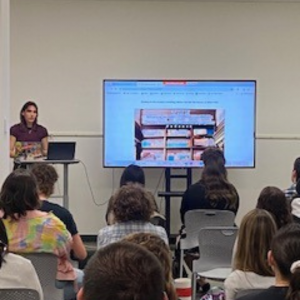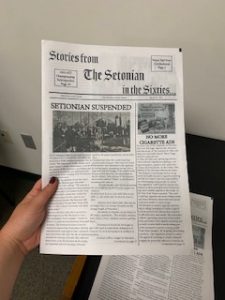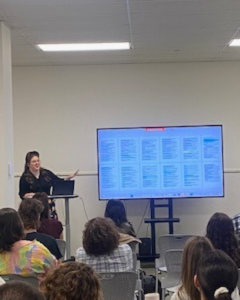On Wednesday, April 24h, as part of the 8th annual Petersheim Exposition, our five Time Machines researchers presented their final projects to an audience of their peers, advisors, and faculty. In addition to the presentations, the Archives staff displayed all of the objects that were featured in the presentations.
Pegi Bracaj
Object of Choice: The Miriam Rooney Papers

To tell the story of Miriam Rooney, Bracaj created a three episode podcast entitled “The Echoes of the Archives: Unveiling Hidden Gender Narratives at Seton Hall”. The first episode “delves into the university’s gendered past, from its origins as a male-only institution to its transition to coeducation.” The second episode “explores the often overlooked stories of women within the university’s archives. ” The third and final episode dives deeper into Miriam Rooney herself, uncovering “Rooney’s achievements as the Dean of Seton Hall University School of Law, her academic and professional journey, and her multifaceted contributions to the community.” To supplement the podcast, Bracaj also created a webpage that provides a brief biography of Miriam Rooney and details her collection of papers held here in the Archives. You can view Bracaj’s project here.
Eman Fatima
Objects of Choice: Coin, Mughal Dynasty; Coin, 1/4 Anna

Eman Fatima, who moved to the US from Pakistan at age 16, wrote an op-ed entitled “The Construction of Two Coins: The Past and the Present”. The piece utilizes the two coins as symbols of just how far reaching the impact of British colonization had on and continues to have on South Asia.
Austin DelSontro
Object of Choice: The Setonian Newspapers, 1924-2024


Inspired by the 100th anniversary of The Setonian, Austin DelSontro originally sought to examine the entire Setonian archive, but instead chose to focus his research on The Setonian in the 1960s upon learning the publication was briefly banned in 1964. In his presentation, DelSontro selected a few stories from the 1960s, such as Seton Hall transitioning into a coed institution, the Setonian ban and the protests that erupted as a result, and a retrospective on the 1953 men’s basketball team and their experience at the NIT championship. In addition to his presentation, Delsontro also created his own newspaper in both a physical and digital format. You can view the digital version here.
Collin Doyle
Object of Choice: Journal of Roy Fitzsimmons, 1937-1938


Collin Doyle took the research from the Roy Fitzsimmons’s journal documenting the MacGregor Arctic Expedition and through Mathmatica, produced three-dimensional maps that represent the same part of the Arctic that was traversed during the expedition. In doing so, Doyle illustrated the importance of climate consciousness through the creation of interactive visualizations of sea level rise. Doyle also presented a poster that features direct quotes from the journal.
Hope Mahakian
Object of Choice: WWII Ration Books, 1943

Hope Mahakian, dressed in 1940s inspired attire, presented her video on the history of ration books and how they were used during WWII, followed by her friends’ attempts at recreating popular recipes during the US rationing period. The first half of the video is edited in the style of a 1940’s informercial, while the recipe recreation was done more like a modern day vlog. You can watch the video for yourself here.
Congratulations to all of our student researchers on a job well done, and a special thanks to the Archives staff and faculty advisors for your support throughout this project!
